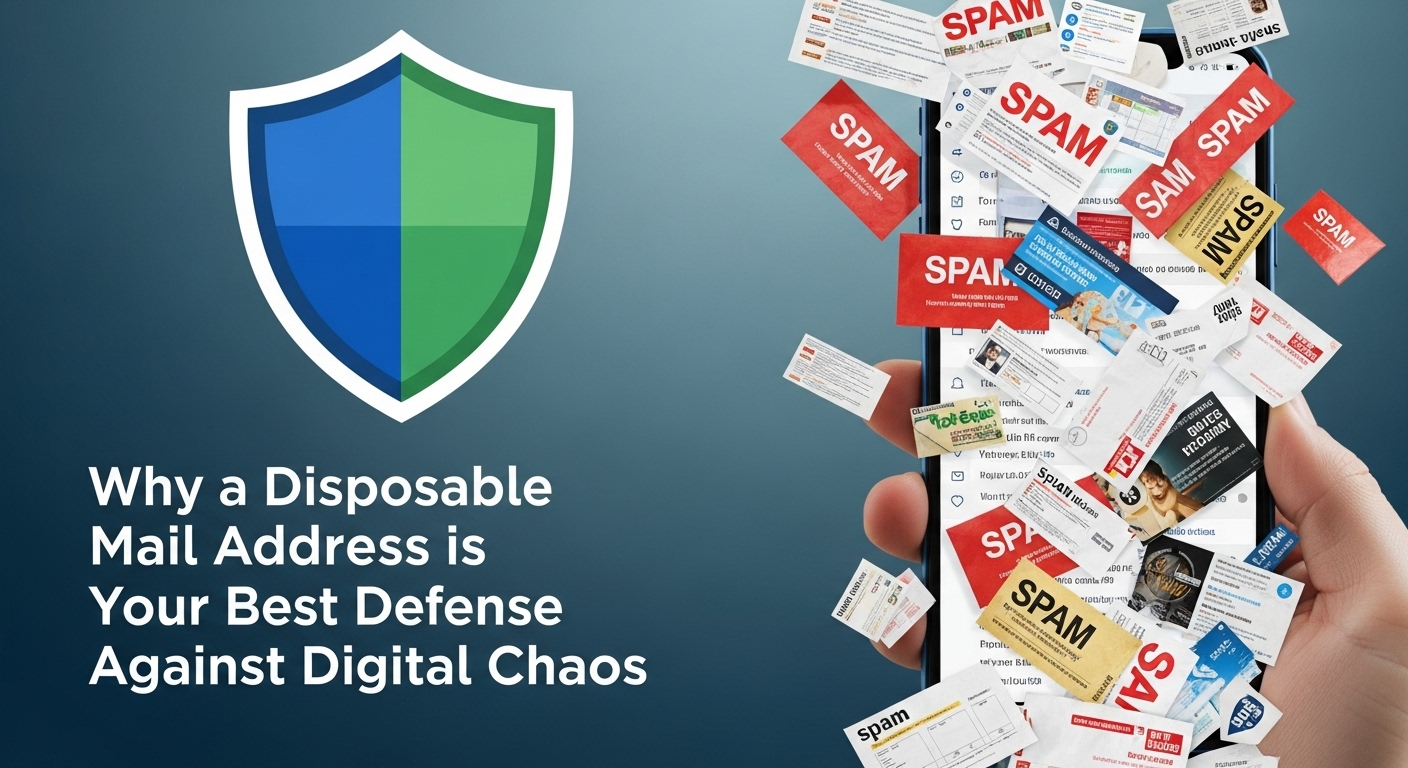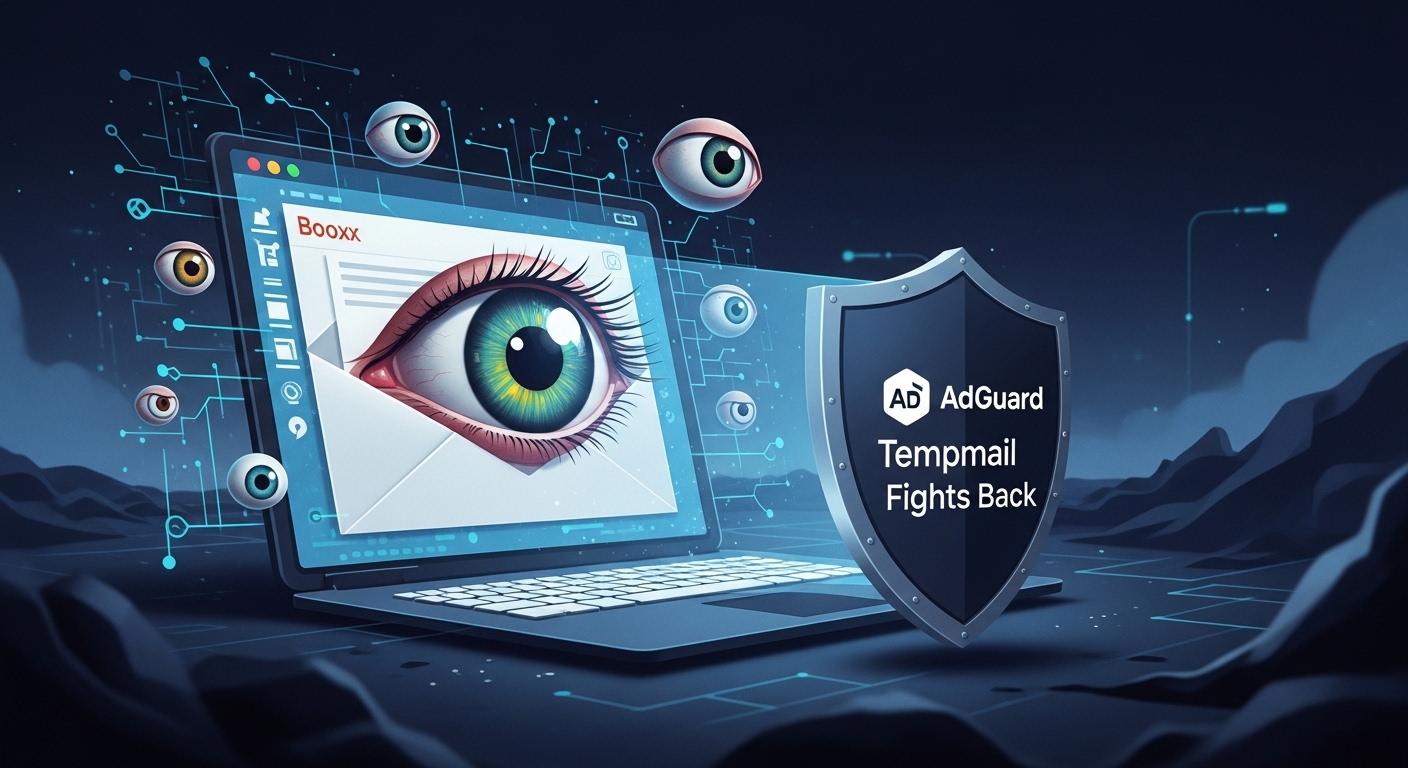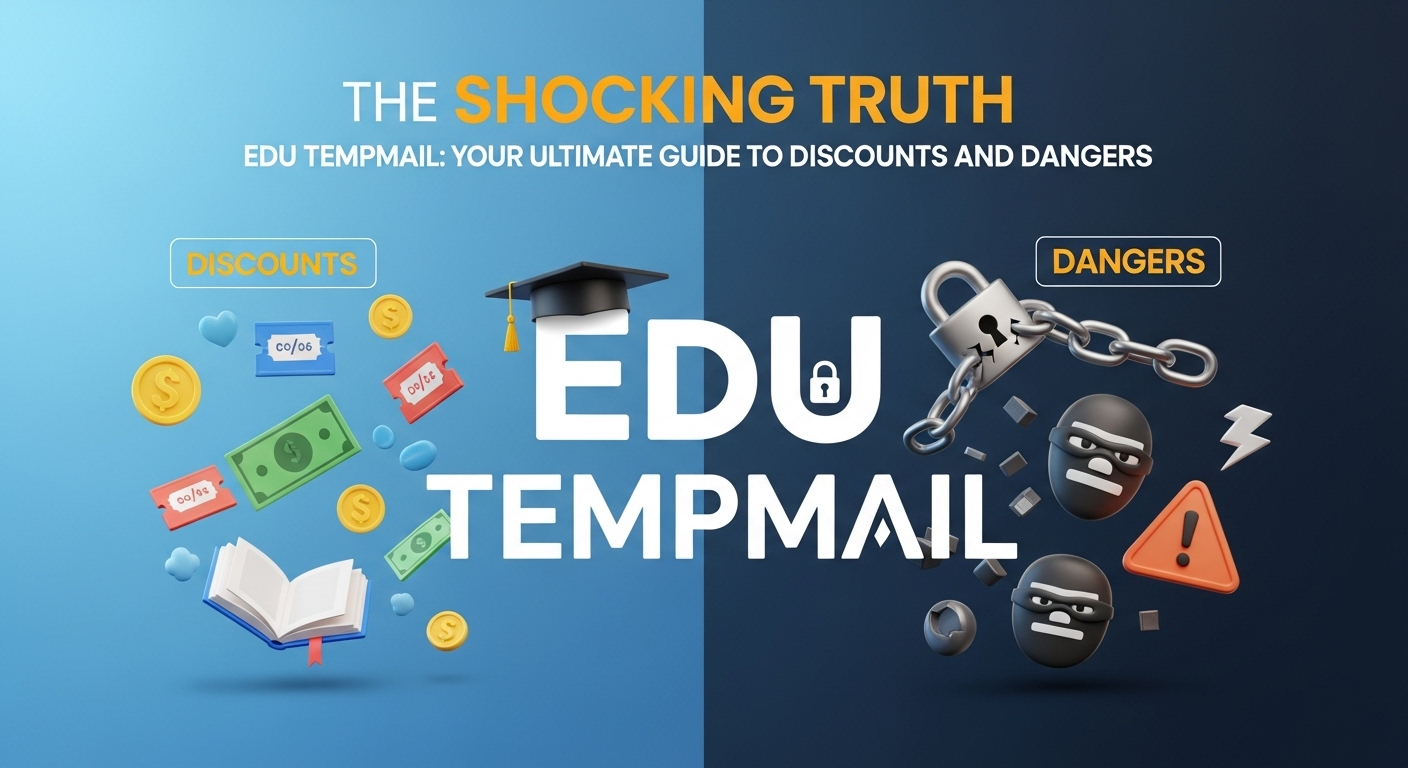Why a Disposable Mail Address is Your Best Defense Against Digital Chaos

You’ve been there. You find an interesting e-book, a useful software trial, or a tempting 10% discount code. But there’s a catch—a digital gatekeeper demanding a toll: your email address. You hesitate, knowing that handing it over is like inviting an army of marketers, spammers, and potential scammers directly into your digital home. The feeling is justified. In 2025, the world is projected to send and receive a staggering 376.4 billion emails every single day.1 The problem? In 2023, a massive 45.6% of all email traffic was pure spam.
What if you had a secret weapon? A simple, powerful tool that acts as a shield, deflecting the spam and safeguarding your real identity. That weapon exists, and it’s called a disposable mail address. Think of it as a digital disguise, allowing you to navigate the web, sign up for services, and grab those downloads without ever exposing your true self. In this guide, we’ll explore what a disposable mail address is, why it's an essential tool for modern life, how to use it safely, and which services you can trust to guard your privacy.
What Exactly is a Disposable Mail Address?
At its heart, a disposable mail address (often abbreviated as DEA) is a temporary email account created for a specific, short-term purpose. It’s a "burner" for your inbox—you use it once or for a limited time and then discard it, leaving no trace back to your primary email. This simple act of separation is a cornerstone of good digital hygiene.
The Many Names of Anonymity
The digital world loves its jargon, and you'll hear these terms used interchangeably. They all refer to the same core concept:
- Temp Mail: A common name for temporary email services.
- Burner Email: Evokes the idea of a "burner phone," used and then discarded.
- Throwaway Email: Highlights the single-use nature of the address.
- 10-Minute Mail: A specific type of DEA that self-destructs after 10 minutes.
- Fake Mail Generator: A tool that creates a temporary, functional email address.
- Trash Mail: An address destined for the digital garbage bin.
How Do They Actually Work?
While the goal is the same—protecting your real inbox—not all disposable email services work the same way. They generally fall into two categories, a distinction that is critical for you to understand. This isn't just a minor technical detail; choosing the wrong type for your needs can lead to losing access to accounts or failing to protect your privacy effectively. The market has evolved from simple, self-destructing tools to more advanced privacy management systems.
- Temporary Inboxes (The True "Throwaways"): This is the classic model. When you visit a service like 10 Minute Mail, it instantly generates a brand-new email address and a temporary inbox that exists only on their servers. You can receive emails, click verification links, and see attachments. After a set time—be it 10 minutes or 48 hours—the address and its entire inbox are permanently deleted. This is perfect for quick, one-off tasks where you never need to access the account again.
- Forwarding Aliases (The Privacy "Masks"): More advanced services, like those offered by(https://www.startmail.com/) or ProtonMail, use a different approach. Instead of creating a separate inbox, they generate a unique "alias" or "masked" email address that automatically forwards all incoming messages to your real inbox.8 You can create dozens of these aliases—one for Netflix, one for your favorite online store, one for newsletters. If an alias starts receiving spam, you can simply delete it, and the flow of junk mail stops instantly, all without affecting your other communications. This model is designed for long-term privacy management, not just short-term disposability.
!(https://i.imgur.com/example-flowchart.png "Temporary Inbox vs. Forwarding Alias")
Understanding this spectrum is key. A "throwaway" is for a task you want to forget. An "alias" is for a relationship you want to control.
How a Disposable Mail Address Defends Your Digital Life
Using a disposable mail address isn't just about keeping your inbox tidy. It's a strategic defense against a trio of interconnected digital threats that follow a predictable and dangerous pattern. This "Lifecycle of a Leaked Email" often starts with a single, seemingly innocent sign-up and can escalate into serious security risks. A DEA breaks this chain at its very first link.
Pillar 1: Winning the War on Spam
Spam is the visible enemy. It clutters your inbox, wastes your time, and often serves as the delivery vehicle for more sinister threats. With the global email user base set to hit 4.6 billion by 2025, spammers have an ever-expanding pool of targets.
- The Causal Link: You sign up for a service with your real email. That company adds you to marketing lists. They may also sell or share your address with "partners." The result is a never-ending stream of promotional emails you never asked for.
- Case Study: The Retail Sign-Up Trap. You're shopping online and a pop-up offers 15% off your first order if you provide your email. Instead of your primary address, you use a disposable mail address. You receive the discount code in the temporary inbox, apply it at checkout, and then abandon the temporary address forever. You get the savings; your real inbox remains pristine and free from a lifetime of daily "deals".
Pillar 2: Building a Fortress Against Data Breaches
The invisible threat is the data breach. A company you trusted with your email gets hacked, and your credentials are stolen. The average cost of a data breach hit a staggering $4.44 million in 2025, and over half (53%) of all breaches involve customer personally identifiable information (PII), with email addresses being a prime target. In the first half of 2025 alone, an estimated 166 million individuals were impacted by data compromises.
- The Causal Link: The company that spammed you suffers a data breach. Your email and password combination are leaked and sold on the dark web. Hackers now have a key that they will try on every major service—your bank, your social media, your primary email—hoping you reused your password.
- How a DEA Provides "Breach Isolation": If the email address leaked in a breach is a unique, disposable one you used only for that service, the damage is completely contained. The hackers have a useless email and a password that, hopefully, you haven't used anywhere else. Your core digital identity remains secure.
Pillar 3: Dodging the Phishing Hook
Phishing is the active attack. Defined by the(https://www.ftc.gov/business-guidance/small-businesses/cybersecurity/phishing) as a scam using deceptive emails to steal sensitive information, it is the primary entry point for the vast majority of cyberattacks. An estimated 3.4 billion phishing emails are sent every single day.
- The Causal Link: Cybercriminals buy lists of leaked emails from data breaches. They then craft sophisticated phishing emails that look like they come from legitimate services associated with that breach, making the scam far more believable.
- How a DEA Reduces Your Attack Surface: By using a disposable mail address for non-essential sign-ups, you drastically reduce the number of phishing attempts that ever reach your high-value primary inbox. If a scammer sends a phishing email to a dead disposable address, it goes nowhere. You can't click on a link you never receive.
5 Genius Use Cases for a Burner Email
While DEAs are powerful defensive tools, their utility extends far beyond just security. They are instruments of digital empowerment, rebalancing the power dynamic between you and the countless services that demand your data. Using a burner email allows you to engage with the digital world on your own terms.
Here are five practical ways to use a disposable mail address to your advantage:
- The "Try Before You Commit" Free Trial
- Description: We've all been there. You sign up for a 14-day trial of a streaming service or a new productivity app, only to forget to cancel and get hit with an unexpected charge. By using a disposable mail address, you can explore the service fully. If you decide not to continue, you don't have to worry about canceling or receiving endless "please come back" emails. The connection is severed cleanly.3
- The One-Time Download Gatekeeper
- Description: Marketers love to place valuable content—like e-books, industry reports, and webinar recordings—behind an "email wall." They get a permanent marketing lead; you get a PDF. A disposable email lets you access this gated content instantly without subscribing to a newsletter you'll probably never read. It's a fair exchange of temporary access for temporary information.
- The Developer's Sandbox
- Description: For software developers, QA testers, and product managers, DEAs are an indispensable tool. They allow for the rigorous testing of user sign-up forms, email verification flows, and automated onboarding sequences without cluttering production databases with fake user accounts or spamming real inboxes. Services with APIs are particularly useful for this automated testing.
- The Anonymous Commentator
- Description: You want to participate in an online forum, a political discussion board, or the comment section of a news article, but you'd rather not attach your real name or primary email to your opinions. A disposable mail address allows you to register and engage in these conversations while protecting your personal and professional identity from potential backlash or doxxing.
- The Marketplace Negotiator
- Description: When buying or selling items on platforms like Facebook Marketplace or Craigslist, your safety is paramount. Use a disposable email for all initial communications. This allows you to vet the other party, negotiate terms, and arrange a meeting place without revealing your personal contact information until you are comfortable that the transaction is legitimate.
When to NEVER Use a Disposable Email Address
A disposable mail address is a specialized tool, and like any tool, using it for the wrong job can be disastrous. While it offers control over your data, that very "disposability" is also its greatest weakness. The decision to use a DEA is a conscious trade-off: you are exchanging long-term account recoverability for short-term privacy.
Crucial Warning: A disposable email is the wrong tool for any account you cannot afford to lose.
Before using one, always ask yourself: "Is my privacy from this service more important than my ability to recover this account later?"
| Pros of Using a Disposable Mail Address | Cons of Using a Disposable Mail Address |
| ✅ Prevents spam in your primary inbox. | ❌ Permanent loss of account access if you forget your password. |
| ✅ Protects your real identity and enhances privacy. | ❌ Cannot be used for critical services like banking or government. |
| ✅ Isolates your accounts from data breaches. | ❌ Many major websites actively block known disposable domains. |
| ✅ Free and incredibly easy to use for one-off tasks. | ❌ Most free services lack security, encryption, and support. |
| ✅ Ideal for testing services and software trials. | ❌ You will miss important notifications, receipts, or security alerts. |
How to Choose a Reliable Disposable Mail Service
The internet is flooded with temporary email providers. How can you tell a trustworthy service from a shady one? Here is a simple checklist to help you evaluate any service before you use it.
- Read the Privacy Policy: This is non-negotiable. Look for clear language about their data retention and logging policies. Do they record your IP address? If they don't have a privacy policy or it's vague and confusing, close the tab and find another service.
- Assess the Security Model: Does the website use HTTPS (SSL/TLS encryption) to protect your connection? Are the inboxes private, or can anyone who guesses the address view your mail? While rare for free services, any mention of encryption is a huge plus.
- Understand the Business Model: How does the service make money? If it’s free, it’s likely supported by ads. This isn't necessarily a dealbreaker, but it can create a conflict of interest—a service monetizing your activity may not have your privacy as its top priority. Services with a "freemium" model, where paid plans support a limited free tier, often have a more transparent and trustworthy structure.
- Check for Blacklisted Domains: The most popular DEA services often find their domains blocked by major websites like Netflix or Facebook. Before relying on a service for an important sign-up, do a quick search for " blocked" to see if users are reporting issues. Advanced blocklists are even maintained on platforms like GitHub.
- Evaluate the User Experience: A clean, professional, and easy-to-use interface is often a sign of a more reputable operation. If the site is cluttered with aggressive ads, pop-ups, and broken links, it’s a red flag that the service may not be well-maintained or trustworthy.
Conclusion:
Your email address is more than just a contact method; it's a cornerstone of your digital identity. In an online world that is constantly trying to track, monetize, and exploit that identity, a disposable mail address is not just a clever trick—it's an essential act of self-defense.
We've seen that these tools are your first line of defense against the relentless onslaught of spam, a critical shield that provides "breach isolation" in the face of constant data breaches, and a simple way to reduce your exposure to malicious phishing attacks. From testing new software to protecting your anonymity, their practical uses are vast and empowering.
But with this power comes responsibility. Understanding the difference between a true "throwaway" inbox and a long-term privacy "alias" is key. Knowing when not to use a disposable address is just as important as knowing when to use one.
So, don't let your inbox be a free-for-all. The next time a website demands your email, pause. Ask yourself if they've earned your trust. If not, arm yourself with a disposable mail address. Take the first step toward a cleaner, safer, and more private digital life. You are in control.
Frequently Asked Questions (FAQ) About Disposable Mail
1. Are disposable mail addresses legal?
Yes, using a disposable mail address is completely legal for legitimate purposes, such as protecting your privacy, avoiding spam, and testing services. However, using them to engage in illegal activities, such as fraud or harassment, is against the law.
2. Can disposable emails be traced?
It is very difficult, but not impossible. While most reputable disposable email services do not require registration and claim not to log your IP address, a determined adversary or law enforcement agency with a court order could potentially trace activity through other means. They provide a strong layer of anonymity for everyday use, but not absolute, untraceable security.
3. How long does a temp mail last?
The lifespan varies dramatically by provider. Some, like 10 Minute Mail, last for only 10 minutes. Others can last for hours, days, or, in the case of services like Temp Mail, until you manually delete the address or the service cycles its domain names.
4. Can I send emails from a disposable address?
It depends on the service. Many basic providers are receive-only. However, more advanced services like Guerrilla Mail are specifically designed to allow you to both send and receive emails anonymously.
5. Do disposable emails work for Facebook/Gmail/Netflix?
Usually, no. Major online platforms actively maintain blocklists of domains from known disposable email providers to prevent abuse, spam, and the creation of fraudulent accounts. Your registration will likely be rejected.
6. What is the difference between a disposable email and an alias?
A disposable email typically has its own separate, temporary inbox on the provider's server, which expires and is deleted. An alias is a forwarding address that doesn't have its own inbox; it simply directs all incoming mail to your primary, permanent email account. You can then disable the alias to stop receiving mail without affecting your main account.
7. Is it safe to use a temp mail?
It is safe for low-stakes, non-sensitive activities. It is not safe for anything involving personal, financial, or critical information. Most free services lack the robust security, encryption, and privacy guarantees of a premium email provider.
8. Why do websites block temporary emails?
Websites block them to protect themselves from abuse. This includes users who repeatedly sign up for free trials, spammers creating fake accounts for malicious purposes, and bots overwhelming their systems. Blocking disposable domains is a common defense mechanism.
9. Can I recover a disposable email account?
Almost never. The "disposable" nature is their key feature. Once an address expires or is deleted, it is gone forever, along with any emails it contained. There is no recovery process.
10. What is a "burner email"?
A "burner email" is simply another popular slang term for a disposable mail address or temporary email. The terms are used interchangeably to describe an email address that is meant for short-term use before being discarded.
Please don’t forget to leave a review of my article.
You Might Also Like
Is Your Inbox Spying on You? Here’s How AdGuard Tempmail Fights Back
Have you ever paused before entering your email address into a new website, feeling a slight hesitation? That feeling is...

The Shocking Truth About Edu Tempmail: Your Ultimate Guide to Discounts and Dangers
Imagine getting over 60% off Adobe Creative Cloud and half-price Amazon Prime. What if you could get those deals without...

Why Your Hotmail Is a Privacy Nightmare (And How Temp Mail Can Save You)
Did you know that nearly half of all emails sent worldwide are spam? In 2024, spam accounted for a staggering 47.27% of ...

The Ultimate Deception: Is Tempmail Safe, or a Ticking Time Bomb?
Your email inbox is more than just a place for messages. It's the digital key to your entire online life. Every password...

The Ultimate Betrayal: How Your Inbox Is Selling You Out (And How to Use Tempmail to Stop It)
Your inbox is a battlefield. Every single day, a war is waged for your attention, your data, and your money. Don't belie...

Your Digital Shield: The Astonishing Truth About How Temp Mail Works
Opening your email inbox can feel like walking into a battlefield. You’re constantly dodging a barrage of promotional ju...

